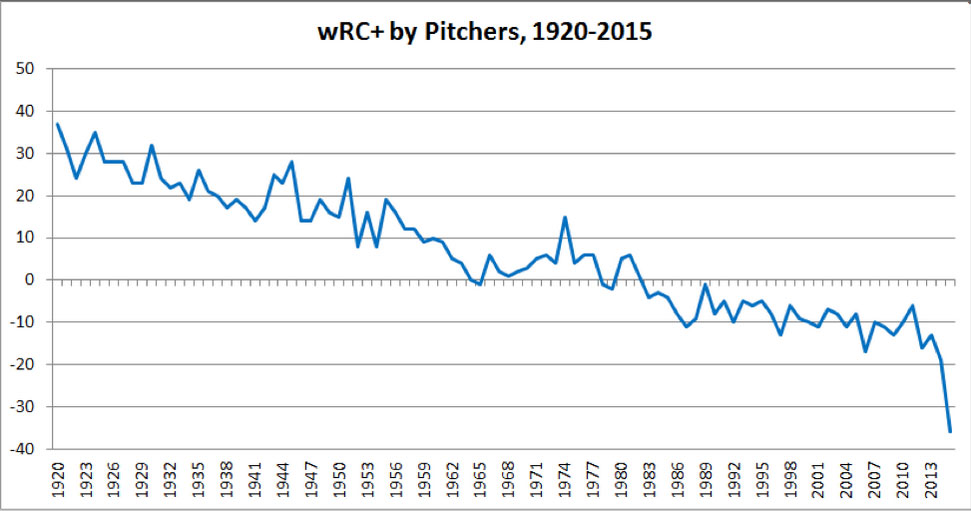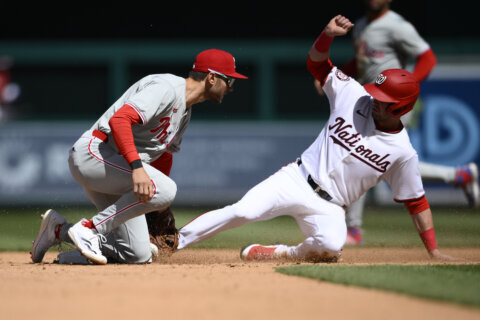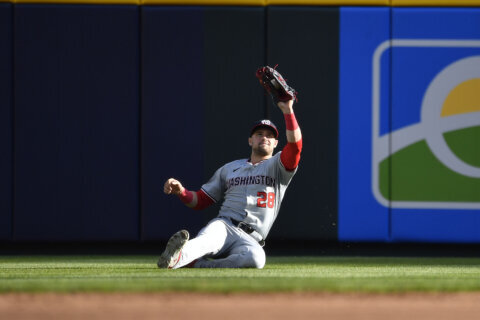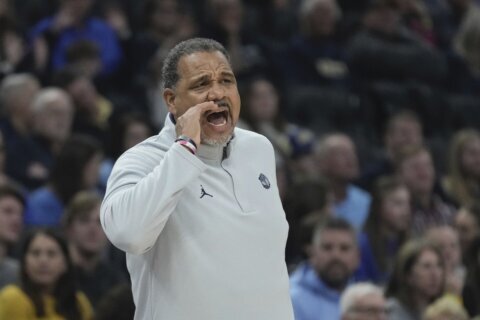WASHINGTON — Before you go running to the comments section, take a deep breath, open your mind and read. Consider this your catalyst for progress, or how you learned to stop worrying and love the designated hitter.
Tuesday night in Atlanta, Max Scherzer is supposed to take the hill for the Washington Nationals as they take on the division-rival Braves. He will not do so, because he jammed his thumb while batting in his last start, Thursday against St. Louis. Scherzer, who is effectively being paid $671,000 per start this season, will miss at least one turn in the rotation.
Speaking of St. Louis, Cardinals ace Adam Wainwright, a four-time top-five Cy Young finisher, is done for the season after just four starts after injuring his Achilles while batting Saturday.
As if pitchers didn’t already face enough threats to their health, two of the best are now unable to do what they are paid handsomely to do.
And let’s be clear — pitchers are not, in any way, paid to hit. You can’t make that argument in today’s game. Jon Lester, who has never had a hit in 44 career at-bats, is being paid $25 million to be the ace of the Chicago Cubs. He may be an extreme example, but National League pitchers combined for a .124 batting average, .156 on-base percentage, and .155 slugging percentage in 2014. AL pitchers slashed .089/.110/.109 when forced to bat in Interleague Play.
Proponents of pitchers hitting often bring up the notion that there is more strategy involved in National League baseball. Even if you haven’t yet come around on the point that bunts are fundamentally a bad idea almost all of the time, there are still many elements of strategy involved in setting lineups to take advantage of platoon splits, and pinch-hitting or playing matchups with relievers.
There’s also the argument made for the few pitchers who actually can hit, that we shouldn’t take away their advantage over their peers. The great thing is, if you have pitchers who can hit, there’s no reason you can’t still use them. The DH has always been optional. If Bruce Bochy wants Madison Bumgarner to hit, that gives the Giants an extra bench player and the versatility to double switch later in the game.
By and large, though, baseball is better when pitchers don’t hit. In a game with diminishing offense, the designated hitter leads to more home runs, the most fan-friendly of all individual plays. It also leads to fewer intentional walks, the hack-a-Shaq of baseball.
Over the past three seasons, the AL has averaged 445 intentional walks, compared to 574 for the NL — 23 percent fewer. Meanwhile, the junior circuit has averaged 2,388 home runs per season over that time, compared to 2,205 for the league with no DH, eight percent more.

In addition to reducing the injury risk for pitchers, a DH in the National League would also help prolong the careers of some of the game’s greatest hitters. You’re telling me the Nationals wouldn’t benefit from being able to rotate Jayson Werth, Ryan Zimmerman and even Wilson Ramos at the spot to save their legs over the course of a 162-game season?
The only reason left to give for why we continue such a self-defeating, injury-creating, offense-killing regulation of the game is tradition — because it’s what we’ve always done. As if rules haven’t changed, or altered, throughout the history of the game. The infield fly rule wasn’t created until 1895. Sacrifice flies didn’t exist until 1908. Rosin bags didn’t exist until 1925. Even the save rule has been modified more recently (1975) than the advent of the DH in the American League (1973).
To that end, the designated hitter is not an experiment. It came into existence the same year as the Watergate trial; the year Roger Moore debuted as James Bond; the year Ernie Banks filled in for the ejected Whitey Lockman to become baseball’s first African American manager; the year George Steinbrenner bought the Yankees from CBS for $12 million.
High school baseball uses a DH. College baseball uses it, too. So does every level of the minor leagues. In fact, pitchers don’t even begin to hit in the minors until Double-A, and even then, teams only play with National League rules if both teams playing are farm affiliates of NL clubs.
Let’s stop pretending like the American League is the outlier. The truth is, the National League is the last bastion of the archaic rule, the equivalent of the old Hall of Fame voter grumpily shaking his fist at all you kids and your silly on-base percentage.
Now isn’t the time for a universal DH. We’ve long since passed that point.







